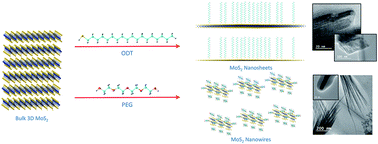MoS2 nanosheets vs. nanowires: preparation and a theoretical study of highly stable and efficient nanofluids for concentrating solar power†
Abstract
The nano-colloidal suspension of nanomaterials in a base fluid, typically named a nanofluid, is a promising system that shows interesting properties, such as those related to heat transfer processes. Obtaining nanofluids with high stability is a priority challenge for this kind of system. So, a rationalization of the preparation of nanofluids is clearly needed. Thus, this study presents a methodology based on liquid phase exfoliation that makes it possible to prepare stable nanofluids and control the morphology of the nanostructures, which is defined by the surfactant used. Two stable nanofluids were prepared based on MoS2 nanosheets and MoS2 nanowires and a typical heat transfer fluid (HTF) used in high temperature applications. Periodic-Density Functional Theory (periodic-DFT) calculations were performed to rationalize why different nanostructures were obtained according to the surfactant used. Finally, enhancements in thermal properties were found, being up to 57% for thermal conductivity and up to 7.5% for isobaric specific heat. Therefore, these nanofluids are a promising alternative to the typical HTF used, which is a eutectic mixture of biphenyl and diphenyl oxide. Also, to our knowledge, controlling the nanostructures obtained and the rationalization of the methodology for the preparation of stable nanofluids is reported for the first time. This leads to highly stable nanofluids with improved thermal properties, promising for application in concentrating solar power.



 Please wait while we load your content...
Please wait while we load your content...